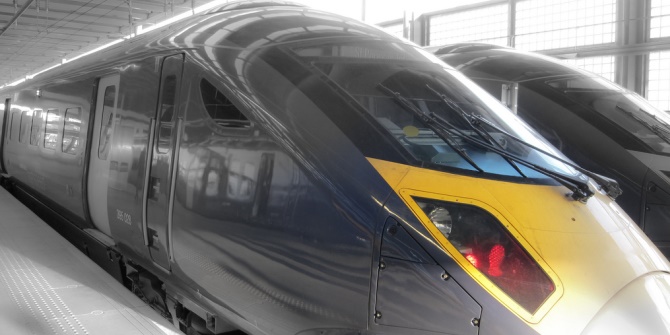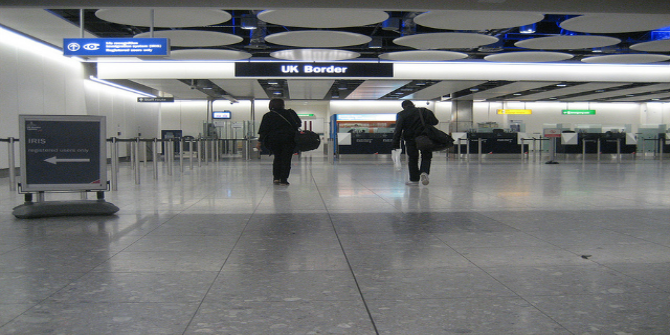 This week George Osborne proposed building high speed rail links between northern cities, dubbed HS3, in order to establish a ‘Northern Powerhouse’ to rival London. Henry Overman chews over the Chancellor’s speech and finds that HS3 would help, but it would be expensive and it’s unlikely that it would be enough to provide an effective counterbalance to London.
This week George Osborne proposed building high speed rail links between northern cities, dubbed HS3, in order to establish a ‘Northern Powerhouse’ to rival London. Henry Overman chews over the Chancellor’s speech and finds that HS3 would help, but it would be expensive and it’s unlikely that it would be enough to provide an effective counterbalance to London.
I have finally had a chance to take a look at George Osborne’s ‘Northern Powerhouse’ speech in which he suggests that a better connected collection of northern cities could take on the world. It’s an interesting (and not entirely new) proposition. But would it work? Could joining up northern cities replicate London’s success?
Crucial to answering this question is the role that scale and physical proximity play in driving London’s success. The evidence suggests that these are pretty important; agglomeration economies arising from scale and proximity help explain London’s success. Once we recognise this, it has fundamental implications for what a more balanced UK economy might need to look like. If creating similar opportunities to London requires similar scale and physical proximity, could we get anywhere near this by ‘joining’ up our Northern cities through greater infrastructure investment? I remain sceptical – not least because our work for the Northern Way estimating the impact of quite substantial reductions in travel times between Manchester and Leeds suggests only modest economic gains. In our work, we looked at the impact of a 20 minute reduction in travel time between Leeds and Manchester. We find that closer integration between Manchester and Leeds could be expected to have a positive effect on wages. Our largest estimate, for a 20 minute reduction in train journey times between Leeds and Manchester, has average wages increasing by between 1.06 per cent and 2.7 per cent.
These numbers come with some important caveats (discussed in more depth here). First, they are certainly not additional for the UK as a whole because a lot of this effect would come from the fact that Manchester and Leeds will be attracting activity that would have gone elsewhere (and not necessarily to London). Second, and related, the effects for an individual worker, with given and unchanging characteristics (often called place-based effects), are smaller at somewhere between 0.20 and 0.50 of a per cent.
In short, joining up our Northern cities (particularly Manchester and Leeds) using HS3 would help, but it would be expensive and it’s unlikely that it would be enough to provide an effective counterbalance to London.
It is also important to note that a project like HS3 to link cities may not be as effective as other interventions. For example, in the detailed report for Northern Way(rather than the more widely quoted summary) we tried to use the same methodology to compare the effect of a 1 per cent reduction in travel times within Manchester or Leeds to the effect of a 1 per cent reduction between those two cities. In all cases, within city reductions in travel times lead to larger increases in ‘economic mass’ (sometimes two to three times larger). As it is these changes in economic mass that underpin any estimated productivity effects, this tells us that a 1 per cent reduction of within city costs would have a larger effect than a 1 per cent reduction of between city costs. Of course, that doesn’t tell us whether we should prefer one over the other – that would depend on the relative costs of achieving these cost reductions (which we didn’t look at). But it does serve to reinforce the point that it might be difficult to replicate London’s advantages from scale and proximity simply by joining up different cities. It also highlights the crucial point that we need to consider the alternatives before rushing headlong for the HS3 solution. I’d argue that this was a mistake we made with HS2 – best not to repeat it.
Of course, part of the attraction of creating a northern powerhouse by joining up cities is that it dodges a very difficult political problem. If balancing the effect of London requires, instead, somewhere ‘big and Northern’ that raises the very difficult question of where that place might be? Politics being what it is, I can see why many people (myself included) would prefer to dodge that particular question.
Note: This article was originally published on the SERC blog and gives the views of the author, and not the position of the British Politics and Policy blog, nor of the London School of Economics. Please read our comments policy before posting. Image credit: Jon Curnow
Henry Overman is professor of economic geography at LSE and director of the What Works Centre for Local Economic Growth.







